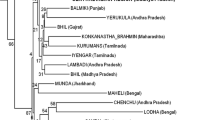Abstract
In the present study, we investigated the genetic polymorphisms of 15 autosomal STR loci in the Russian population of northeastern Inner-Mongolia, China as well as its genetic relationships with other populations. DNA typing for 15 autosomal STR loci was performed on 148 randomly selected healthy individuals from the Russian population living in Eerguna, northeastern Inner-Mongolia. Allelic frequencies of these loci were calculated by direct counting. The genotype data of this Russian population was moreover compared to other populations using neighbor-joining method, as such constructing a phylogenic tree. A total of 143 alleles were found in the Russian population with corresponding allele frequencies in the range from 0.0034 to 0.5372. Among all the 15 loci, D18S51 had the highest polymorphism (PIC = 0.8632), whereas TPOX had the lowest (PIC = 0.5179). In the phylogenic tree, this Russian population has a close relationship with the populations of South Siberia and northeastern Asia. This study may increase our understanding of the genetic background of the Russian population in Eerguna, China as such providing useful information for anthropological research, forensic sciences as well as disease-association studies.


Similar content being viewed by others
References
Sanchez-Diz P et al (2009) Population data on 15 autosomal STRs in a sample from Colombia. Forensic Sci Int Genet 3(3):e81–e82
Hammond HA et al (1994) Evaluation of 13 short tandem repeat loci for use in personal identification applications. Am J Hum Genet 55(1):175–189
Butler JM (2007) Short tandem repeat typing technologies used in human identity testing. Biotechniques 43(4):ii–v
Bowcock AM et al (1994) High resolution of human evolutionary trees with polymorphic microsatellites. Nature 368(6470):455–457
Rowold DJ, Herrera RJ (2003) Inferring recent human phylogenies using forensic STR technology. Forensic Sci Int 133(3):260–265
China NBoSo (2001) The fifth population census. Chinese population statistics year book. Chinese Statistical Publishing House, Beijing
Yang SM, Ding H (2004) Chinese ethnography, 1st edn. Beijing, Central University for Nationalities Press
Suo LY et al (2005) Skinfold thickness and its variations in Russ nationality adults. Nat Sci J 21(3):6
Lv SH et al (2006) A comparison of physical characteristics of Chinese Russ with that of five Russia groups. J Inn Mong Norm Univ, Nat Sci 35(1):99–102
Lv SH et al (2005) A study of the physical characteristics of the Russ nationality. Acta Anthropologica Sinica 24(4):291–300
Zhivotovsky LA et al (2009) Developing STR databases on structured populations: the native South Siberian population versus the Russian population. Forensic Sci Int Genet 3(4):e111–e116
Omran GA, Rutty GN, Jobling MA (2009) Genetic variation of 15 autosomal STR loci in upper (Southern) Egyptians. Forensic Sci Int Genet 3(2):e39–e44
Sotak M et al (2008) Genetic variation analysis of 15 autosomal STR loci in eastern Slovak Caucasian and Romany (Gypsy) population. Forensic Sci Int Genet 3(1):e21–e25
Brisighelli F et al (2009) Allele frequencies of fifteen STRs in a representative sample of the Italian population. Forensic Sci Int Genet 3(2):e29–e30
Rubi-Castellanos R et al (2009) Genetic data of 15 autosomal STRs (Identifiler kit) of three Mexican Mestizo population samples from the States of Jalisco (West), Puebla (Center), and Yucatan (Southeast). Forensic Sci Int Genet 3(3):e71–e76
Wu YM et al (2008) Genetic polymorphisms of 15 STR loci in Chinese Han population living in Xi’an city of Shaanxi province. Forensic Sci Int Genet 2(2):e15–e18
Wang Z et al (2005) Genetic polymorphisms of 15 STR loci in Chinese Hui population. J Forensic Sci 50(6):1508–1509
Zhu B et al (2005) Genetic analysis of 15 STR loci of Chinese Uigur ethnic population. J Forensic Sci 50(5):1235–1236
Yan J et al (2007) Genetic analysis of 15 STR loci on Chinese Tibetan in Qinghai province. Forensic Sci Int 169(1):e3–e6
Miller SA, Dykes DD, Polesky HF (1988) A simple salting out procedure for extracting DNA from human nucleated cells. Nucl Acids Res 16(3):1215
Guo SW, Thompson EA (1992) Performing the exact test of Hardy–Weinberg proportion for multiple alleles. Biometrics 48(2):361–372
Tereba A (1999) Tools for analysis of population statistics: profiles in DNA, vol 2. Promega Corporation, pp 203
Nei M, Roychoudhury AK (1974) Sampling variances of heterozygosity and genetic distance. Genetics 76:379–390
Kumar S et al (2008) MEGA: a biologist-centric software for evolutionary analysis of DNA and protein sequences. Brief Bioinform 9(4):299–306
Tang G (2004) Russian descendants in the dongbei China: race’s name and ethnic group’s identification. Siberian Studies 31(5):5
Tang H (2001) On cultural Identity of the Russian Chinese in Erguna and its development. J Inner Mongolia Polytechnic Univ Soc Sci 10(1):6
Roewer L et al (2008) Analysis of Y chromosome STR haplotypes in the European part of Russia reveals high diversities but non-significant genetic distances between populations. Int J Legal Med 122(3):219–223
Acknowledgments
This project supported by the National Natural Science Foundation of China (Nos. 30700470 and 30871348), and the Shaan’xi Provincial Science and Technology Research and Development Project Fund (No. 2008K09-02), China. We would like to thank all donors for making this work possible, Dr. Natalia Bogatcheva for the nice suggestions and Dr. Zhivotovsky for the kind helps with the figures in this manuscript.
Author information
Authors and Affiliations
Corresponding author
Additional information
The first two authors equally contributed to this work.
Rights and permissions
About this article
Cite this article
Zhu, Bf., Yang, G., Shen, Cm. et al. Population genetic analysis of 15 autosomal STR loci in the Russian population of northeastern Inner-Mongolia, China. Mol Biol Rep 37, 3889–3895 (2010). https://doi.org/10.1007/s11033-010-0045-y
Received:
Accepted:
Published:
Issue Date:
DOI: https://doi.org/10.1007/s11033-010-0045-y



